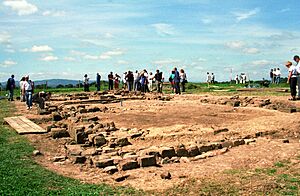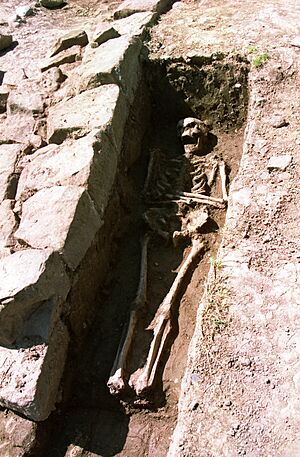Poulton Chapel facts for kids
Poulton Chapel was an old church building from the Middle Ages. It was located in a small village called Poulton, Cheshire, in England. This area is very close to the border with Wales.
Monks from Poulton Abbey built the chapel around the year 1153. Later, between 1199 and 1214, the monks moved to a new place called Dieulacres. Their old abbey became a large farm, known as a monastic grange. The chapel then served as a simple church for the lay brothers who worked on the farm.
In 1487, a family called Manley leased the farm. They made the chapel bigger. During the English Civil War (1642-1651), the chapel was used as a stable for horses. It also served as a lookout point. By 1672, the chapel was falling apart. It was completely taken down by 1718. Today, no parts of the chapel can be seen above ground.
Contents
History of Poulton Chapel
Early Beginnings
Archaeologists believe there was an even older building on this spot. It might have been a simple, single-room structure from the Saxon period. This idea comes from finding about 170 pieces of Anglo-Saxon pottery. These pieces, especially "Chester Ware" from the 900s, were found with the earliest parts of the chapel.
Building the Chapel
The later chapel was built by Cistercian monks. These monks were part of a special religious group. Their main home was Poulton Abbey. The abbey itself was started between 1153 and 1158. However, it must have been founded by 1153 at the latest. This is because a powerful person named Ranulf de Gernon, who was involved, died in 1153. The exact spot of the abbey is still a mystery. No parts of it are left above ground.
Poulton Abbey was connected to Combermere Abbey. Combermere Abbey was founded in 1133. Abbot William of Combermere started Poulton Abbey. He received land for it from Robert Pincerna Le Botiller. Ranulf de Gernon, a powerful Earl, was a prisoner at the time. Pincerna wanted prayers said for the Earl. When the Earl was freed, he supported the abbey. He gave the monks a fishing spot in the River Dee. He also let them grind their corn for free at his mill in Chester. Many other gifts were given to the abbey.
The chapel building seems to have been built around the same time as the abbey, about 1153. It started as a single room, called a nave.
Life as a Farm Chapel
After the abbey moved to Dieulacres, the Poulton site became a "grange." This was like a large farm estate owned by the monks. The chapel was kept in good condition. It was used by the "lay brothers." These were monks who did not become priests but worked on the farm.
In 1487, the abbey rented the Poulton Hall estate to the Manley family. Sir Nicholas Manley made the chapel bigger. He added a chancel (the area around the altar) and a tower. It became his family's private chapel.
The Chapel's Last Days
Old maps show where the chapel was located. An estate map from before 1675 recorded it. Later maps, and even the first Ordnance Survey map, also showed the old chapel.
The chapel was still standing in 1544. The King gave it to Sir George Cotton. The rest of the abbey buildings had already fallen apart. The chapel was last used during the English Civil War (1642–1651). Parliamentarian soldiers used it as a stable and a lookout. By 1672, people said it was in ruins. It was completely torn down by 1718.
Chapel of Mary of Poulton
The chapel was sometimes called the "Chapel of Mary of Poulton." This name appeared in a document from the 1500s.
The document describes people gathering at the chapel. It says: "A long time ago when we kept vigil in the chapel of Mary of Poulton, the gwŷr wrth gerdd [bardic craftsmen] would sing cywyddau and awdlau and the women would sing carolau and dyrïau."
This means that during a special gathering, perhaps on the evening before a religious holiday, people would sing and tell stories. It shows the chapel was an important place for the community. It might have even been a place where people went on a pilgrimage, a special journey for religious reasons.
Archaeological Discoveries
The site of Poulton Chapel has been studied by archaeologists since 1995. First, Chester Archaeological Services and Liverpool John Moores University worked together. Later, the Poulton Research Project took over. They have been digging around the chapel and other nearby areas.
In 2006, the site was featured on a TV show called Time Team. The show tried to find the abbey's location but did not succeed. However, they did find that a large farm, later known as Poulton Hall, was about 500 meters from the chapel.
Professor Mick Aston suggested a theory about the chapel. He thought it might have been a "Capella ad Portem." This means a "chapel by the gate." It would have been a chapel for local people who could not easily get to the main abbey chapel. Other chapels like this exist, such as St. Stephens at Bordesley Abbey.
Archaeologists are still finding burials from the medieval graveyard. As of 2015, over 800 burials have been uncovered.
Besides the chapel, archaeologists have found Roman ditches. These ditches contained many Roman objects. This suggests that an important Roman building was once on the site. It also links the Roman presence to the Legio XX Valeria Victrix, a Roman army group, in Chester.
Even older evidence has been found. Archaeologists discovered signs of people living there during the Iron Age. They found ditches from round houses. Dr. Kevin Cootes, the site director, believes the findings suggest the site was used for producing and preserving meat. This meat was likely preserved by salting and then traded.



